New Record of the Huberia from the Posongchong Formation, Pragian Stage, Lower Devonian Series in the Bainiuchang Area, Southeastern Yunnan, China
Abstract
1. Introduction
2. Materials and Methods
3. Description and Comparison
3.1. Description
3.1.1. KUSTPSCHS401
3.1.2. KUSTPSCHS402
3.1.3. KUSTPSCHS403
3.1.4. KUSTPSCHS404
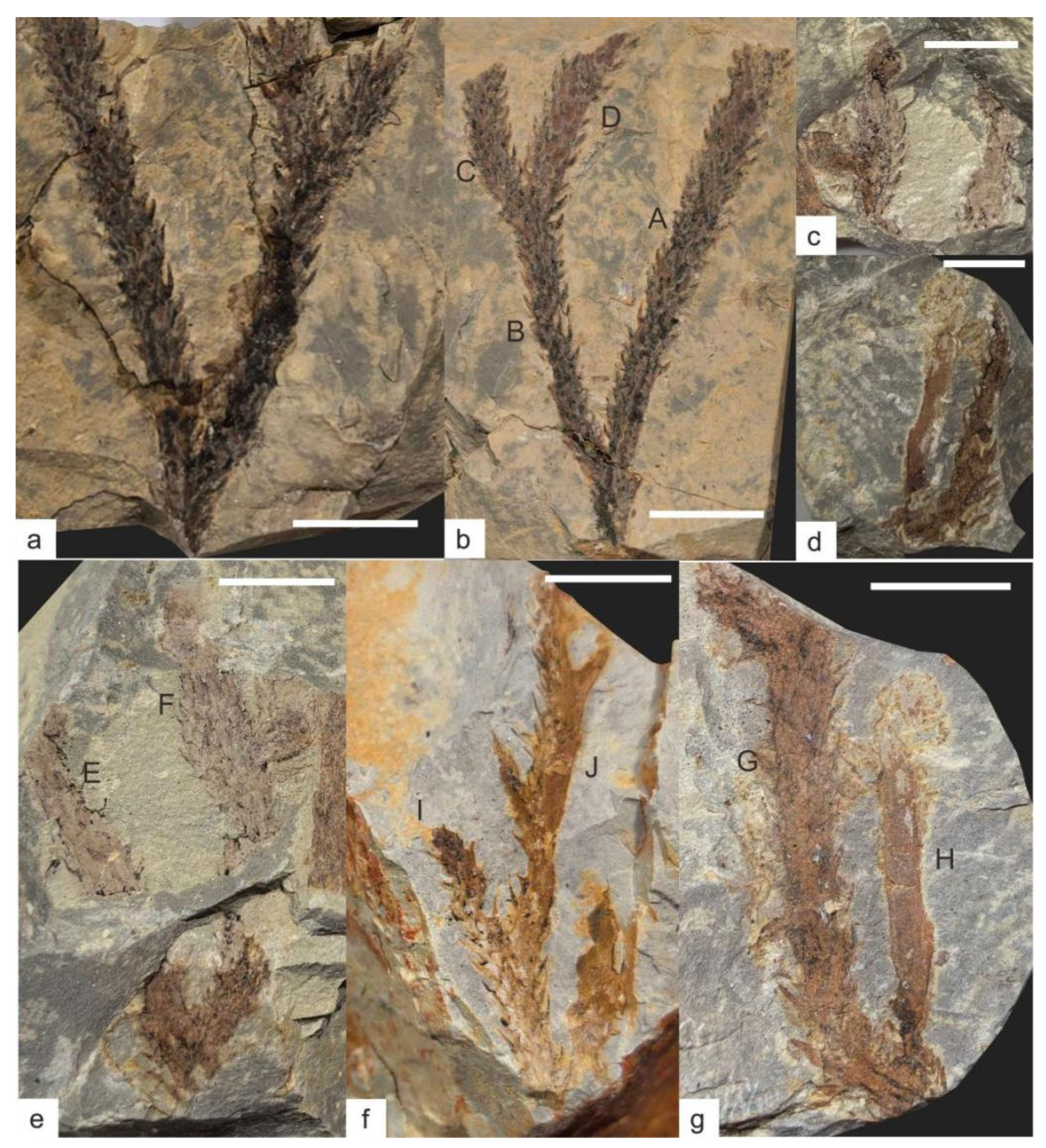
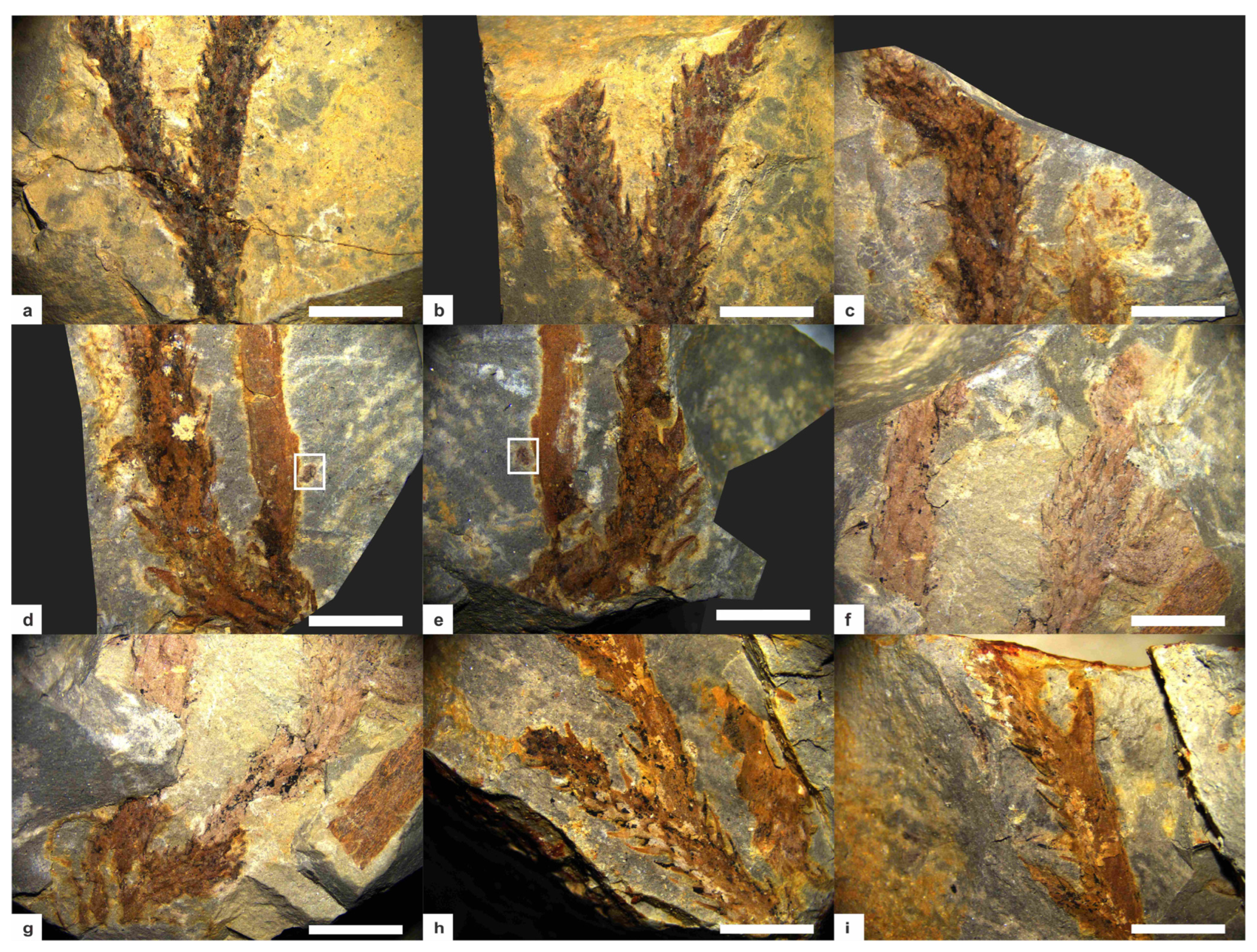
3.2. Comparison
| Hueberia zhichangensis | Hueberia zhichangensis | Hueberia bainiuchangensis | |
|---|---|---|---|
| STEMS | |||
| Branching pattern | Frequently isotomous | Frequently isoanisotomous | Dichotomus |
| Rhizome width (mm) | 1.3–1.8 | 1.1–3.4 | - |
| Aerial stem width (mm) | 1.3–1.8 | 0.9–2.8 | 2.0–4.9 |
| BUDS | |||
| Distribution | - | Irregular | - |
| Width (mm) | - | 0.7–1.2 | - |
| Length (mm) | - | 0.7–2.6 | - |
| ENATIONS or MICROPHYLLS | |||
| Arrangement | Helical; 6–8 per gyre | Helical; 6–8 per gyre | Helical; 6–8 per gyre |
| Morphology | Falcate enations | Falcate microphylls | Falcate microphylls |
| Width (mm) | 0.6–1.0 | 0.1–0.5 | 0.1–1 |
| Length (mm) | 0.9–1.6 | 0.7–2.3 | 1.7–3.2 |
| Height of bases (mm) | - | 0.6–1.6 | - |
| SPORANGIA | - | ||
| Outline in face view | - | Rounded | Rounded |
| Size (mm) | - | 0.6–0.9 | 0.85–1.1 |
| REFERENCES | Yang et al., 2009 [12] | Xue, 2013 [13] | This study |
3.3. Systematic Paleontology
4. Discussion
| Test Item | Unit | Test Result | Test Item | Unit | Test Result | Test Item | Unit | Test Result | Test Item | Unit | Test Result |
|---|---|---|---|---|---|---|---|---|---|---|---|
| K2O | % | 4.52 | V | μg/g | 100 | Cs | μg/g | 28.8 | Tm | μg/g | 0.655 |
| Al2O3 | % | 20.81 | Mn | μg/g | 64.2 | Ba | μg/g | 452 | Yb | μg/g | 4.26 |
| CaO | % | 0.07 | Co | μg/g | 4.43 | B | μg/g | 93.7 | Lu | μg/g | 0.638 |
| TFe2O3 | % | 2.41 | Ni | μg/g | 19.1 | La | μg/g | 54.1 | Hf | μg/g | 5.72 |
| MgO | % | 0.904 | Cu | μg/g | 11.9 | Ce | μg/g | 110 | Ta | μg/g | 1.4 |
| Na2O | % | 0.233 | Zn | μg/g | 35.8 | Pr | μg/g | 12.6 | W | μg/g | 2.36 |
| SiO2 | % | 64.41 | Ga | μg/g | 24.7 | Nd | μg/g | 50.7 | Ti | μg/g | 0.987 |
| MnO | % | 0.007 | Rb | μg/g | 193 | Sm | μg/g | 9.59 | Pb | μg/g | 31.4 |
| P2O5 | % | 0.057 | Sr | μg/g | 68.9 | Eu | μg/g | 1.67 | Bi | μg/g | 0.511 |
| TiO2 | % | 0.819 | Y | μg/g | 37.9 | Gd | μg/g | 8.6 | Th | μg/g | 24.3 |
| Li | μg/g | 78.5 | Zr | μg/g | 262 | Tb | μg/g | 1.32 | U | μg/g | 3.57 |
| Be | μg/g | 2.37 | Nb | μg/g | 19.2 | Dy | μg/g | 7.53 | In | μg/g | 0.099 |
| Sc | μg/g | 12.9 | Mo | μg/g | 0.412 | Ho | μg/g | 1.45 | |||
| Ti | μg/g | 4842 | Cd | μg/g | 0.038 | Er | μg/g | 4.32 |
| Redox Indicator | RRs [30] | Result | Paleoclimate | RRs [33] | Result |
|---|---|---|---|---|---|
| Ni/Co | Oxidizing environment < 7 Anoxic environment > 7 | 4.31 | Sr/Cu | Arid climate > 10 Semi-arid climate 5–10 Humid climate < 5 | 5.79 |
| V/(V+Ni) | Oxidizing environment < 1.5 Anoxic environment > 1.5 | 0.84 | |||
| U/Th | Oxidizing environment < 1.25 Anoxic environment > 1.25 | 0.15 | |||
| Ceanom | Oxidizing environment < 0 Anoxic environment > 0 | −0.03 |
5. Conclusions
Author Contributions
Funding
Institutional Review Board Statement
Informed Consent Statement
Data Availability Statement
Acknowledgments
Conflicts of Interest
References
- Chapin, F.S., III; Matson, P.A.; Vitousek, P.M.; Chapin, M.C. Principles of Terrestrial Ecosystem Ecology, 2nd ed.; Springer: New York, NY, USA, 2011; pp. 3–22. [Google Scholar]
- Wang, D.M.; Qin, M.; Liu, L.; Liu, L.; Zhou, Y.; Zhang, Y.Y.; Huang, P.; Xue, J.Z.; Zhang, S.H.; Meng, M.C. The most Extensive Devonian Fossil Forest with Small Lycopsid Trees Bearing the Earliest Stigmarian Roots. Curr. Biol. 2019, 29, 2604–2615.e2. [Google Scholar] [CrossRef] [PubMed]
- Xue, J.Z.; Shen, B.; Huang, P. How did plants colonize land and reshape Earth’s surface systems? Earth Sci. 2022, 47, 3849–3850. [Google Scholar] [CrossRef]
- Xue, J.Z.; Wang, J.; Li, B.; Huang, R.; Liu, L. Origin and Early Evolution of Land Plants and the Effects on Earth’s Environments. Earth Sci. 2022, 47, 3648–3664. [Google Scholar]
- Hao, S.G.; Wang, D.M. The Early Devonian Posongchongflora of Yunnan, China—A window for research on evolution and diversity of early land vascular plants. Adv. Earth Sci. 2003, 18, 877–883. [Google Scholar]
- Liao, W.H.; Xu, H.K.; Wang, C.Y.; Ruan, Y.P.; Cai, C.Y.; Mu, D.C.; Lu, L.C. The Subdivision and Correlation of the Devonian Stratigraphy of Southwest China. In Devonian System of South China; Institute of Geology and Mineral of Chinese Academy of Geological Sciences. Geology Press: Beijing, China, 1978; pp. 193–213. [Google Scholar]
- Hao, S.G.; Gensel, P.G. The Posongchong Floral Assemblages of Southeast Yunnan China-Diversity and Disparity in Early Devonian Plant Assemblages. In Plants Invade the Land: Evolutionary and Environmental Considerations; Gensel, P.G., Edwards, D., Eds.; Columbia University Press: New York, NY, USA, 2001; pp. 103–119. [Google Scholar]
- Hao, S.G. A new zosterophyll from the Lower Devonian (Siegenian) of Yunnan China. Rev. Palaeobot. Palynol. 1989, 57, 155–171. [Google Scholar] [CrossRef]
- Wang, Y. Lower Devonian miospores from Gumu in the Wenshan District, southeast Yunnan. Acta Micropalaeontol. Sin. 1994, 11, 319–332. [Google Scholar]
- Gerrienne, P. A biostratigraphic method based on a quantification of fossil tracheophyte characters—Its application to the Lower Devonian Posongchong flora (Yunnan Province China). J. Palaeosci. 1996, 45, 194–200. [Google Scholar] [CrossRef]
- Zhang, S.H.; Xiao, L.; Xue, J.Z.; Meng, M.C.; Qin, M.; Cui, Y.; Wang, D.M. Characteristics of stable carbon isotope of the Early Devonian plants from Yunnan Province and its palaeoclimatic significance. J. Palaeogeogr. 2021, 23, 887–900. [Google Scholar] [CrossRef]
- Yang, N.; Li, C.S.; Edwards, D. Hueberia zhichangensis gen. et sp. nov, an Early Devonian (Pragian) Plant from Yunnan, China. Palynology 2009, 33, 113–124. [Google Scholar] [CrossRef]
- Xue, J.-Z. New material of Hueberia zhichangensis Yang, Li and Edwards, a basal lycopsid from the Early Devonian of Yunnan, China. Neues Jahrb. Für Geol. Paläontologie—Abh. 2013, 267, 331–339. [Google Scholar] [CrossRef]
- GB/T 14506.28-2010; Methods for Chemical Analysis of Silicate Rocks—Part 28: Determination of 16 Major and Minor Elements Content. General Administration of Quality Supervision, Inspection and Quarantine of the People’s Republic of China: Beijng, China; Standardization Administration of the People’s Republic of China: Beijng, China, 2010.
- Hao, S.G.; Xue, J.Z. The Early Devonian Posongchong Flora of Yunnan—A Contribution to an Understanding of the Evolution and Early Diversification of Vascular Plants; Science Press: Beijing, China, 2013; pp. 63–182. [Google Scholar]
- Li, D.Y.; Ge, H.R. Early Land Plants and Environment in Yunnan; Yunnan Science and Technology Press: Kunming, China, 2001; pp. 1–6. [Google Scholar]
- Xiong, C.H.; Huang, P.; Wang, D.; Xue, J.Z. A Dataset of Paleozoic Vascular Plants from the South China Block, V1; Science Data Bank: Beijing, China, 2020. [Google Scholar] [CrossRef]
- Xue, J.Z.; Hao, S.G. Phylogeny, episodic evolution and geographic distribution of the Silurian-Early Devonian vascular plants: Evidences from plant megafossils. J. Palaeogeogr. 2014, 16, 861–877. [Google Scholar] [CrossRef]
- Liu, L.; Wang, D.M.; Meng, M.C.; Xue, J.Z.; Tang, Y.G. New advances in studies of devonian lycopsids. Acta Palaeontol. Sin. 2018, 57, 344–355. [Google Scholar] [CrossRef]
- Russell, A.D.; Morford, J.L. The behavior of redox-sensitive metals across a laminated-massive-laminated transition in Saanich Inlet, British Columbia. Mar. Geol. 2001, 174, 341–354. [Google Scholar] [CrossRef]
- Shi, L.; Feng, Q.L.; Shen, J.; Ito, T.; Chen, Z.Q. Proliferation of shallow-water radiolarians coinciding with enhanced oceanic productivity in reducing conditions during the Middle Permian, South China: Evidence from the Gufeng Formation of western Hubei province. Palaeogeogr. Palaeoclimatol. Palaeoecol. 2016, 444, 1–14. [Google Scholar] [CrossRef]
- Diao, H.; Jiang, Y.M.; Chen, Z.Y.; Ding, F.; Yu, Z.K.; Xu, J.Q.; Yu, Q.; Wang, W.L. Reconstruction of the Paleoenvironment of Eocene Source Rocks in Xihu Sag, East China Sea Based on Major and Trace Elements and Biomarkers. Rock. Miner. Anal. 2025, 1–12. [Google Scholar] [CrossRef]
- Yan, B.; Zhu, X.K.; Tang, S.H.; Qi, L. Characteristics of Sr isotopes and rare earth elements of cap carbonates in Doushantuo Formation in the Three Gorges area. Geoscience 2010, 24, 832–839. [Google Scholar]
- Olivier, N.; Boyet, M. Rare earth and trace elements of microbialites in Upper Jurassic coral-and sponge-microbialite reefs. Chem. Geol. 2006, 230, 105–123. [Google Scholar] [CrossRef]
- Jones, B.; Manning, D.A.C. Comparison of geochemical indices used for the interpretation of palaeoredox conditions in ancient mudstones. Chem. Geol. 1994, 111, 111–129. [Google Scholar] [CrossRef]
- Algeo, T.J.; Maynard, J.B. Trace-element behavior and redox facies in core shales of Upper Pennsylvanian Kansas-type cyclothems. Chem. Geol. 2004, 206, 289–318. [Google Scholar] [CrossRef]
- Liu, X.M.; Hardisty, D.S.; Lyons, T.W.; Swart, P.K. Evaluating the fidelity of the cerium paleoredox tracer during variable carbonate diagenesis on the Great Bahamas Bank. Geochim. Cosmochim. Acta 2019, 248, 25–42. [Google Scholar] [CrossRef]
- Elderfield, H.; Greaves, M.J. The rare earth elements in seawater. Nature 1982, 296, 214–219. [Google Scholar] [CrossRef]
- Ji, S.C. Element Geochemistry of the Phosphorus Mudstone in Madingo Formation, Lower Congo Basin: Implications for Paleoceanic Environment. Master’s Thesis, China University of Geosciences, Wuhan, China, 2019. [Google Scholar]
- Fan, Q.S.; Xia, G.Q.; Li, G.J.; Yi, H.S. Analytical methods and research progress of redox conditions in the paleoocean. Acta Sedimentol. Sin. 2022, 40, 1151–1171. [Google Scholar] [CrossRef]
- Haskin, M.A.; Haskin, L.A. Rare earths in European shales: A redetermination. Science 1966, 154, 507–509. [Google Scholar] [CrossRef]
- Zhang, T.F.; Sun, L.X.; Zhang, Y.; Cheng, B.; Li, Y.F.; Ma, H.L.; Lu, C.; Yang, C.; Guo, G.W. Geochemical characteristics of the Jurassic Yanan and Zhiluo Formations in the northern margin of Ordos Basin and their paleoenvironmental implications. Acta Geol. Sin. 2016, 90, 3454–3472. [Google Scholar]
- Lerman, A.; Baccini, P. Lakes-Chemistry, Geology, Physics. J. Geol. 1978, 88, 249–250. [Google Scholar] [CrossRef]
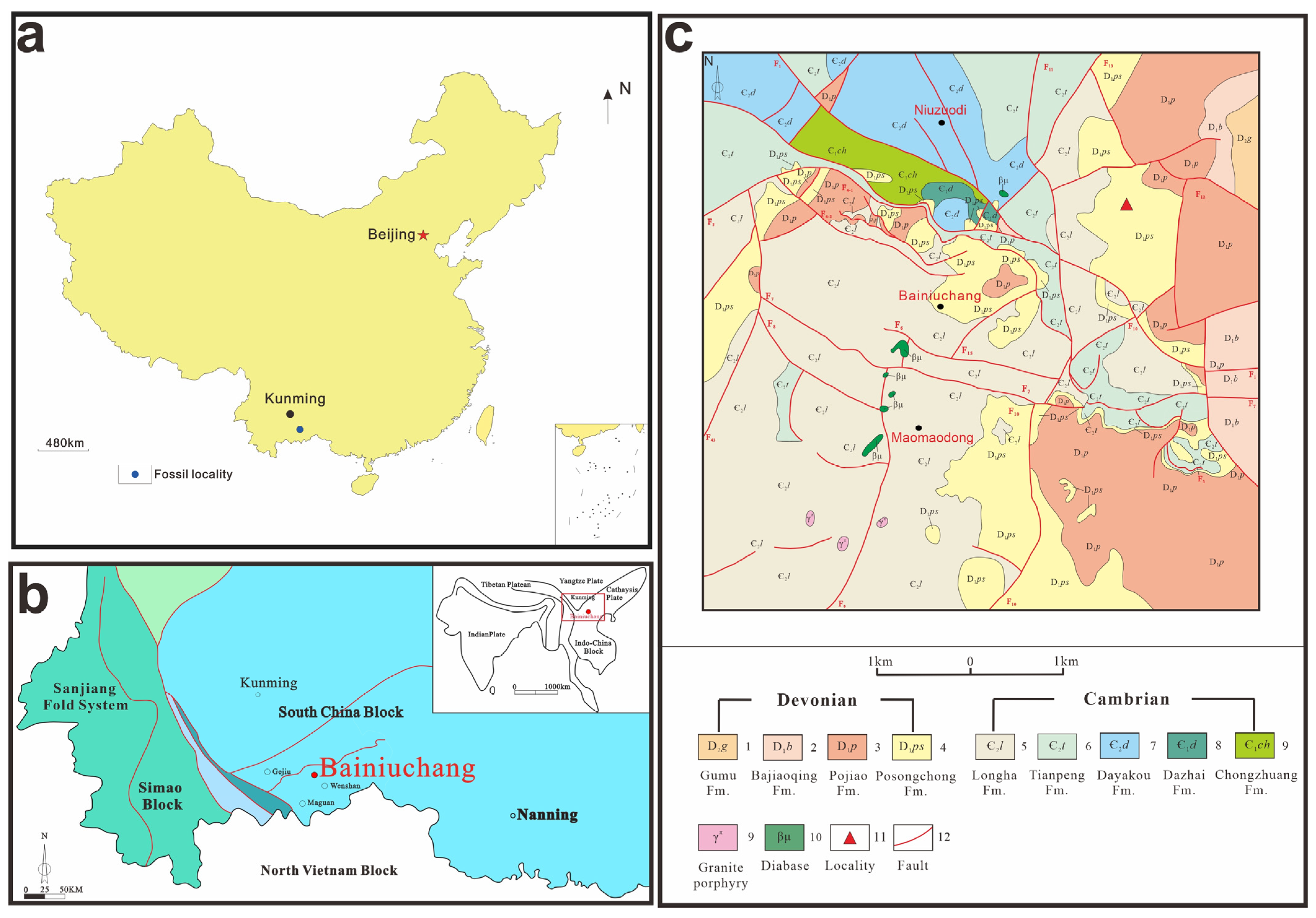
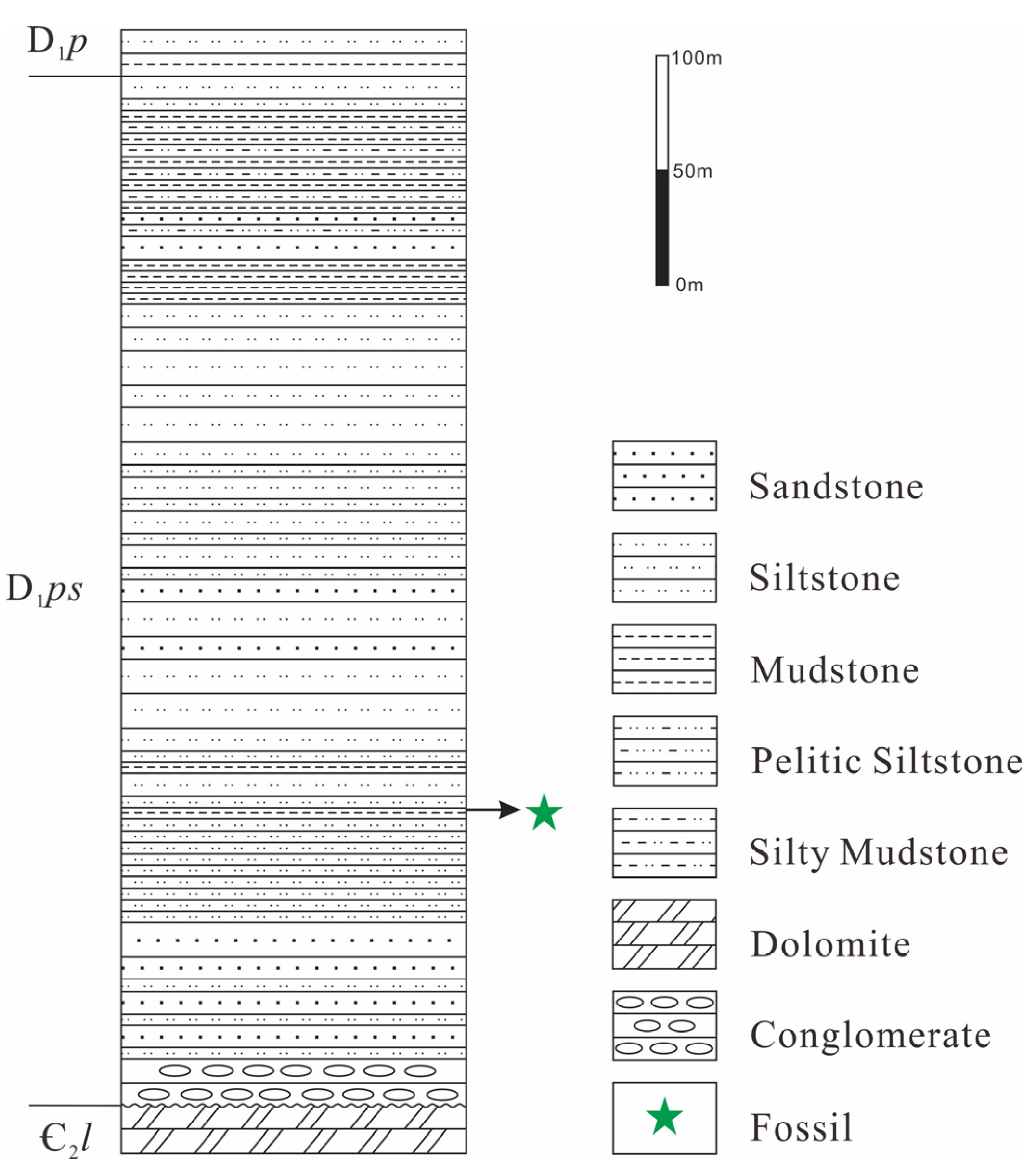
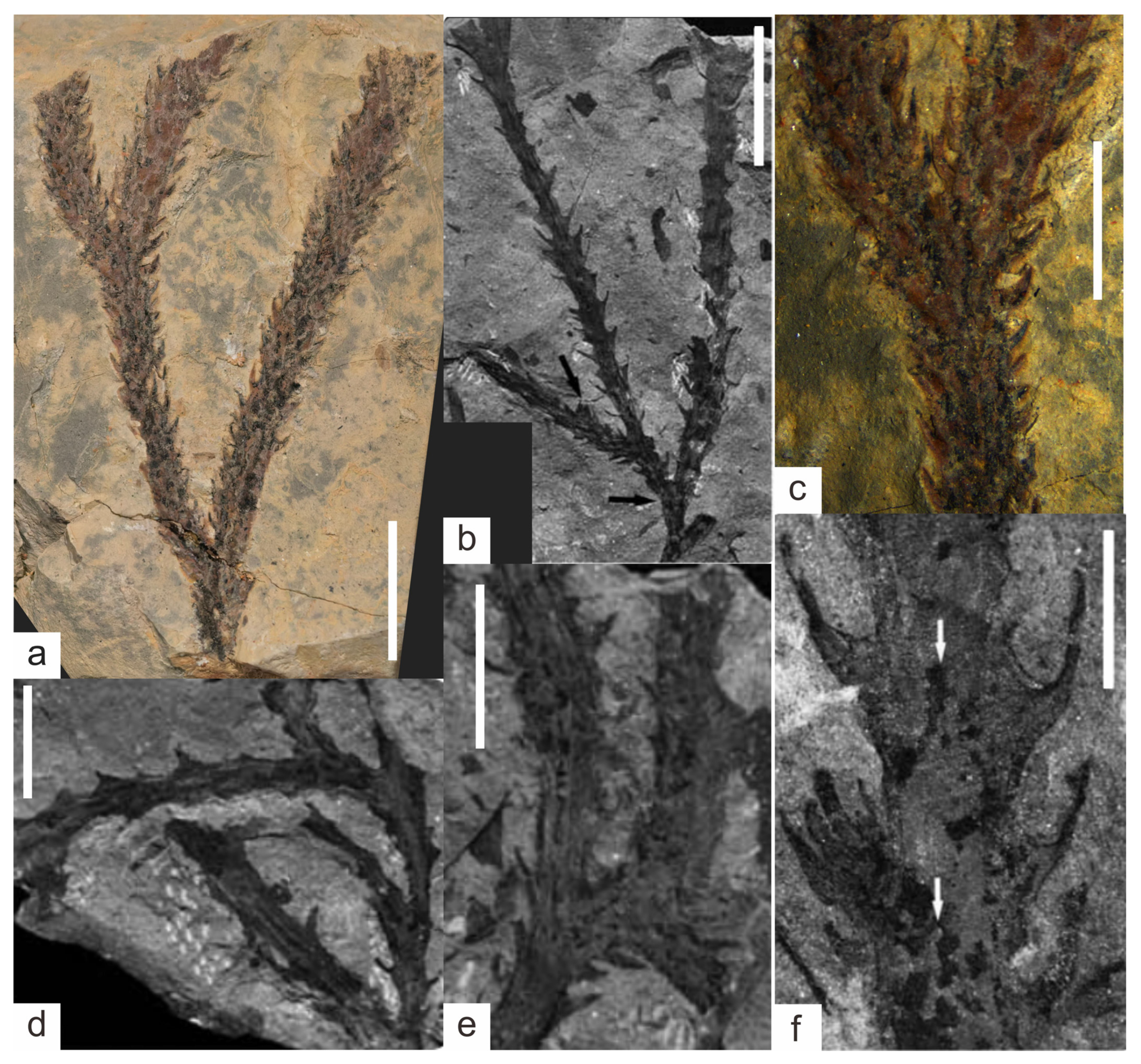
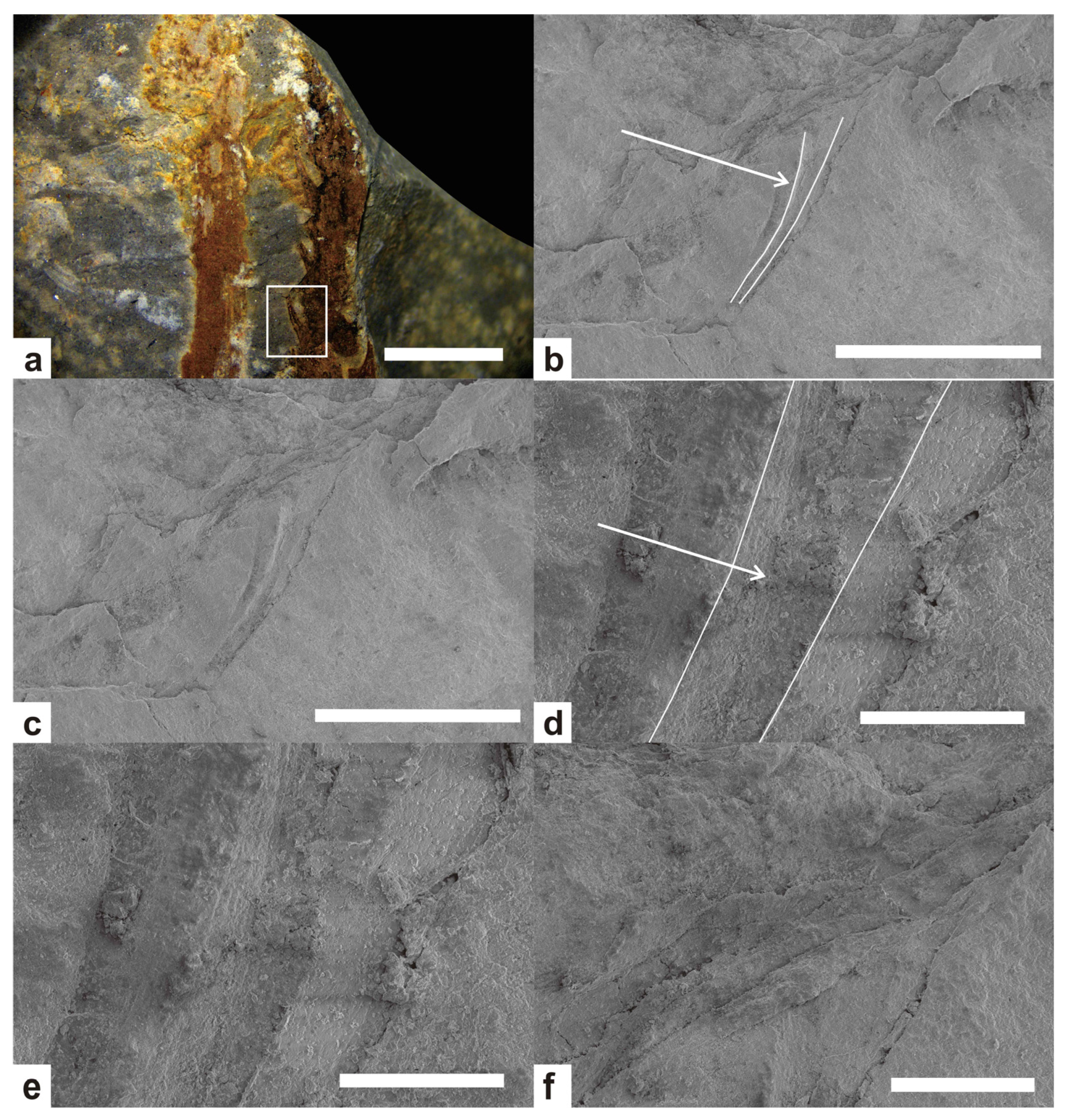
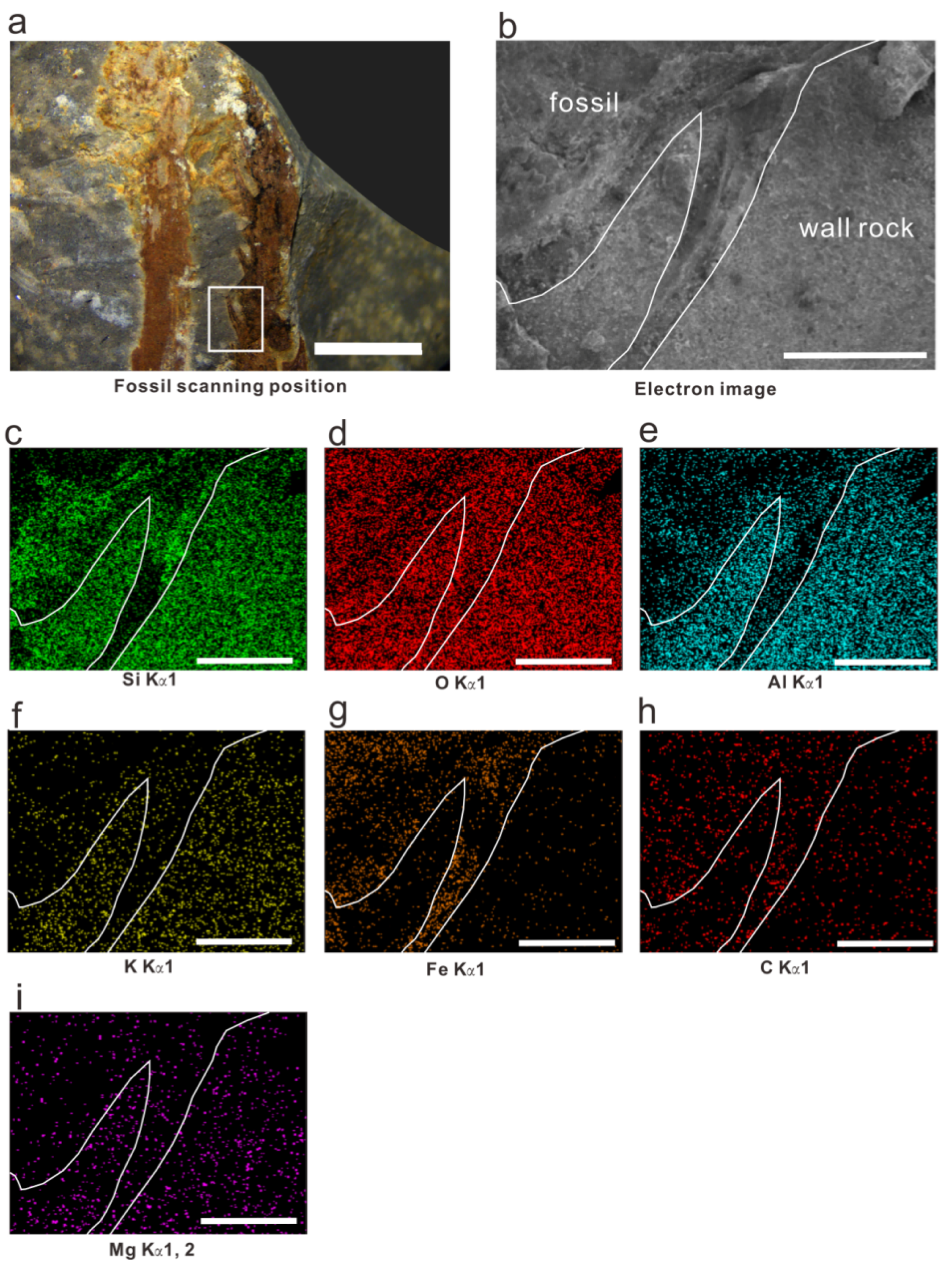
Disclaimer/Publisher’s Note: The statements, opinions and data contained in all publications are solely those of the individual author(s) and contributor(s) and not of MDPI and/or the editor(s). MDPI and/or the editor(s) disclaim responsibility for any injury to people or property resulting from any ideas, methods, instructions or products referred to in the content. |
© 2025 by the authors. Licensee MDPI, Basel, Switzerland. This article is an open access article distributed under the terms and conditions of the Creative Commons Attribution (CC BY) license (https://creativecommons.org/licenses/by/4.0/).
Share and Cite
Hu, Y.; Zhang, S.; Chen, L.; Chen, X.; Xiao, S.; Yin, H.; Zuo, R.; Wang, T.; Yang, X. New Record of the Huberia from the Posongchong Formation, Pragian Stage, Lower Devonian Series in the Bainiuchang Area, Southeastern Yunnan, China. Life 2025, 15, 1663. https://doi.org/10.3390/life15111663
Hu Y, Zhang S, Chen L, Chen X, Xiao S, Yin H, Zuo R, Wang T, Yang X. New Record of the Huberia from the Posongchong Formation, Pragian Stage, Lower Devonian Series in the Bainiuchang Area, Southeastern Yunnan, China. Life. 2025; 15(11):1663. https://doi.org/10.3390/life15111663
Chicago/Turabian StyleHu, Yukai, Shitao Zhang, Liurunxuan Chen, Xianchao Chen, Shangyunzhi Xiao, Haonan Yin, Ruohan Zuo, Tao Wang, and Xiaoqi Yang. 2025. "New Record of the Huberia from the Posongchong Formation, Pragian Stage, Lower Devonian Series in the Bainiuchang Area, Southeastern Yunnan, China" Life 15, no. 11: 1663. https://doi.org/10.3390/life15111663
APA StyleHu, Y., Zhang, S., Chen, L., Chen, X., Xiao, S., Yin, H., Zuo, R., Wang, T., & Yang, X. (2025). New Record of the Huberia from the Posongchong Formation, Pragian Stage, Lower Devonian Series in the Bainiuchang Area, Southeastern Yunnan, China. Life, 15(11), 1663. https://doi.org/10.3390/life15111663






